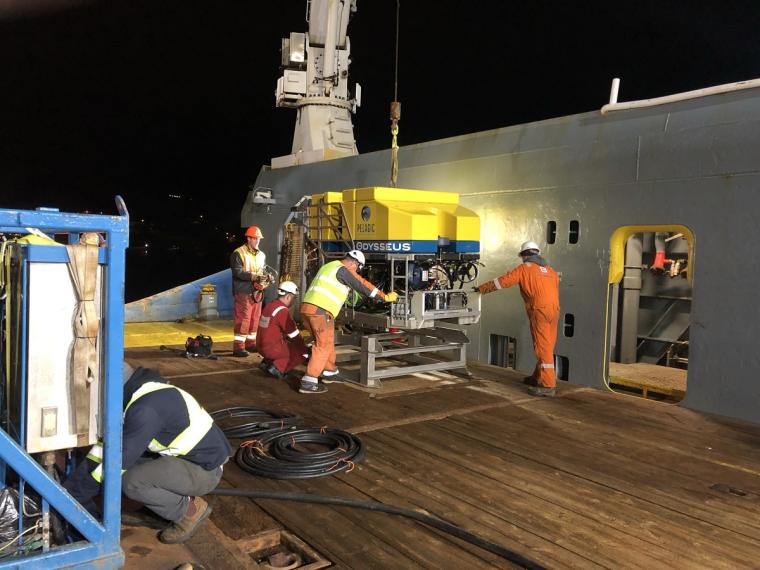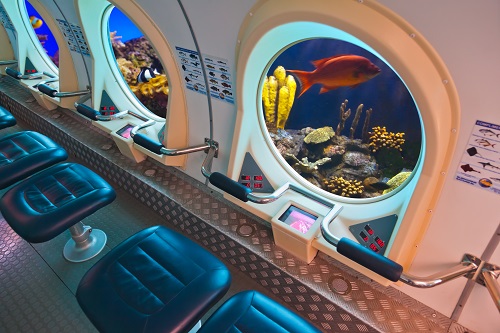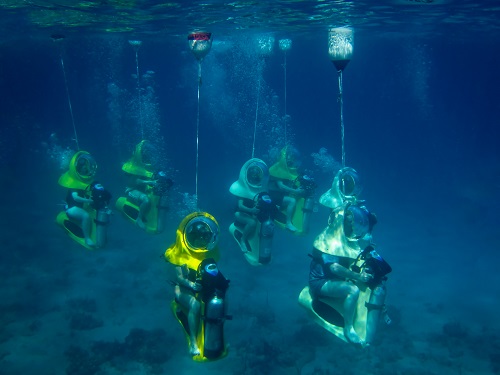
An undated photo from Pelagic Research Services shows mobilization of remote-controlled, unmanned undersea vessels to assist with the Titan search and rescue effort. Image courtesy of Pelagic Research Services.
It seems as though deep sea tourism is a bit like space tourism: Everyone wants to do it – until they don’t, and usually, they don’t because something high-profile and catastrophic, and completely tragic, has occurred.
It was back in early January of 2019 that SDM first told its readers about a company located in the Port of Everett, which had created a miniature submarine capable of diving all the way down to the storied wreck of the Titanic.
The private company, Washington state based OceanGate, had designed and built its most high-profile venture, the Titan, a carbon fiber and titanium submersible. And the enterprise was garnering headlines everywhere, since it appealed to everyone from science buffs to history aficionados to romantics – all of whom had been captivated with the history of the so-called unsinkable ship that went down in 1912, claiming 1,500 lives in the process.
Ultimately, it wasn’t until in 2021, one pandemic and one lightning storm later that the company began sending down passengers to view the Titanic. Successful (but pricey: $250,00 per person) excursions ran that year, and in the next two.
Then came tragedy. On Sunday, June 18, the surface ship that launched the submersible completely lost communication with Titan. After frantic searches with international assistance, the dreaded news came that a debris field had been located off the bow of the Titanic, followed by the news that the debris was that of the Titan, with no hope of survival for those on board.
The submersible that found the debris field was remotely operated, and belonged to Pelagic Research Services, which on its website, describes itself as “an ocean services company that brings expedition planning, execution and state of the art sub-sea research tools to the ocean community on a global basis.”
Five people had been in the Titan, including OceanGate CEO Stockton Rush, 61, and four “mission specialists,” a term the company uses for its passengers, who paid up to $250,000 for a seat. They included British businessman Hamish Harding, 58, French maritime and Titanic expert Paul-Henri Nargeolet, 73, British-Pakistani businessman Shahzada Dawood, 48, and his son Suleman, 19. (In an ironic twist of fate, Rush’s widow is the great-great granddaughter of retailing magnate Isidor Straus and his wife, Ida, both of whom perished on the Titanic.)

Up until now, underwater tourism has been a growing trend. In fact, the BBC noted it had become a bucket list attraction. Endeavors like the world's first underwater hotel, the Conrad Maldives Rangali Island; the world's largest underwater restaurant Under in Norway (as well as a number of other installations) have been increasingly luring wealthy travelers to explore new worlds under the ocean's surface, even if they lack the specialist training.
SCUBA has been popular for decades, thanks to the pioneering efforts of (and great TV shows featuring) the late explorer Jacques Cousteau; however, an industry of attractions has sprung up for those who want to avoid the trouble of training. One, on the Great Barrier Reef, allows people to submerge while wearing a large glass helmet. Dressed in a protective suit, "divers" are gently lowered to the ocean floor, where they can walk on the sand, connected by tubes that allow them to breathe normally while underwater, according to the article. In other areas, uncertified divers can ride what are known as SCUBA scooters to see the underwater sights.
And shipwrecks in general, outside of the Titanic, have long attracted tourists. While the Outer Banks area, long known as the “graveyard of the Atlantic,” holds numerous wrecks, the waters off the PNW have the moniker of “graveyard of the Pacific” and are similarly a popular diving attraction. Additionally, recently discovered wrecks with special historical and cultural significance, such as the São José Paquete D’Africa, a slave ship that sank off Cape Town in 1794, have attracted the attention of individuals and groups with those interests. The Clotilda, another slave shipwreck which lies along the coast near Mobile, Alabama, also draws underwater tourism.
Submersibles, for those who fear threats from marine life (including but not limited to sharks) present an attractive way to experience not just wrecks but the natural beauty of the underwater world. In fact, submersibles in tourism economies like Hawai’i regularly ferry visitors around to look at the sights beneath the surface. Unlike the Titan, however, most of those go less than a third of a mile down; the Titanic wreck rests on the ocean floor, close to two and a half miles down.
And while expeditions like those on the Titan have been seen as too expensive for most tourists, they may not always remain that way. Patricia Rodiles Martinez, Institutional Development and Public Relations Manager of Les Roches, who held the first Space and Underwater Tourism Universal Summit in 2019, told BBC reporters that submersible tourism will necessarily become more affordable. “As demand increases over time, the costs associated will also come down, making it more and more accessible for all. This is what happened with the first airplanes, cruises and hotels.”
Whether or not submersible rides will become mainstream is open to debate (particularly in light of what just happened); however, they have the ability to educate audiences on the importance of conservation, as well as providing a close-up look at the threats to the sea posed by pollution and other factors.
The problem, as was pointed out in numerous articles, is that such tourism is largely unregulated, or is covered by a patchwork of laws that differ from country to country and region to region. In many cases, the questions of who, exactly, owns a wreck and who has the right to explore it, come into play. On the high seas where the Titan and other submersibles operate, there are no regulations and there is no government that controls international waters.
OceanGate CEO Stockton Rush was known for flouting safety rules, making him, in an ironic way, like those who did not equip the Titanic with enough lifeboats. According to CNN, “two former employees of OceanGate voiced separately voiced similar safety concerns about the thickness of the submersible’s hull when they were employed by the company years ago, and a statement from a research lab appears to show conflicting information about the engineering and testing that went into the development of the vessel.” One employee was fired and the other left voluntarily, saying he did not want to be associated with an endeavor that did not follow regulations.

Stockton, when questioned about the safety of the vessel, maintained a decidedly casual attitude, said reporters at CNN. “At some point, safety just is pure waste,” Stockton told journalist David Pogue in an interview last year. “I mean, if you just want to be safe, don’t get out of bed. Don’t get in your car. Don’t do anything.”
It wasn’t the only time he made it clear that he had flouted rules. “I think it was General MacArthur who said you’re remembered for the rules you break,” Rush said in a video interview with Mexican YouTuber Alan Estrada last year. “And I’ve broken some rules to make this. I think I’ve broken them with logic and good engineering behind me.”
The issue that has come front and center is that Titan’s steering was created using the wireless Logitech F710 gamepad. (The Verge notes that Titan advertised “state-of-the-art lighting and sonar navigation systems plus internally and externally mounted 4K video and photographic equipment,” and this CBS News Sunday Morning segment from David Pogue, taken last summer, showed the reporter laughing as he was shown its controls. In the video, Rush holds up the F710, saying, “We run the whole thing... with this game controller.” The reporter refers to the “MacGyver jury-riggedness” of the whole thing, using many off-the-shelf parts, as Rush said, “certain things, you want to be button down,” noting work with Boeing and NASA.)
However, it is worth noting that the US Navy uses gamepads to control submarine periscopes and the photonic masts that have replaced them, and The Boring Company has shown an Xbox One controller steering one of its massive drilling machines.
Undoubtedly, the tragedy of those on the Titan is a devastating blow to the budding industry of underwater tourism, at least the kind that uses submersibles. Perhaps, say some experts, it is time to hit the pause button.
The Conversation says it best: “There’s an ongoing debate in scientific circles regarding the relative merit of manned submersibles, wherein each deployment incurs a safety risk – and the safety of the crew and passengers is paramount.
Currently, most underwater research and offshore industrial work is conducted using unmanned and robotic vehicles. A loss to one of these vehicles might compromise the work being done, but at least lives aren’t at stake. In light of these events, there will likely be intense discussion about the risks associated with using these systems to support deep-sea tourism.”
And, of course, if the chatter on social media and the overall backlash are any indication, it will be a very long time before the general public wants anything to do with a vessel that goes to the ocean floor again, no matter how interesting the attraction.
By Wednesday, the comment feature on the OceanGate social media accounts had been disabled.

